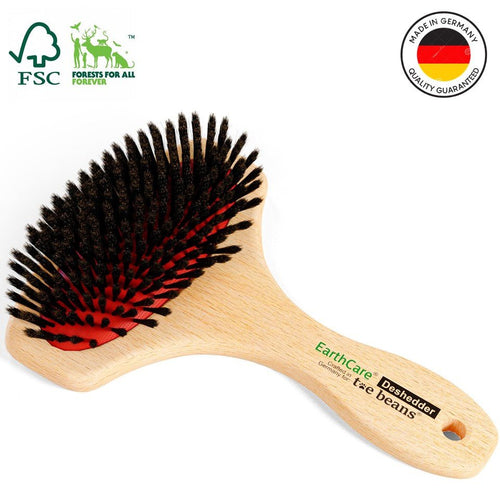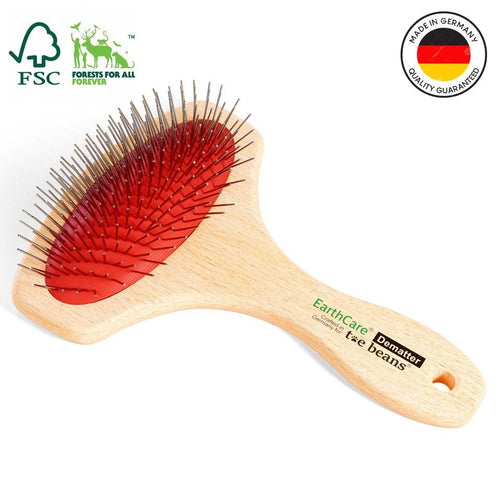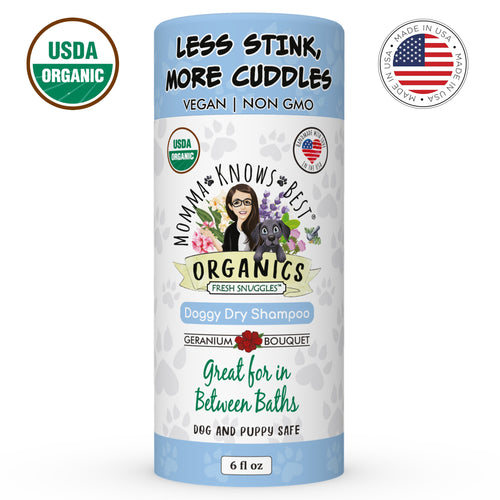Your Cart is Empty
Free 2-5 day delivery | No minimum purchase required
Free 2-5 day delivery | No minimum purchase required
Shop
Learn
Top 9 Large Dog Breeds That Keep Shedding to a Minimum
 by K Marie Alto Updated
9 min read
by K Marie Alto Updated
9 min read

One of the never-ending tasks involved in raising our canine companions is dealing with their fur coats. Dogs shed when the weather changes, and sometimes it can feel like you have a whole second dog's worth of fur on your brush by the end of the day. I mean, just look at a video like this!
And, of course, the larger the dog, the larger the pile of fur they shed every year.
So, if you want to adopt a large breed, but you don't want to deal with enough shed fur to stuff a couch every year, what are your options? There are a bunch of different breeds that are either low-shed or nearly no-shed, so why not pick one of them?
Table of Contents
#1: Portuguese Water Dogs
First on our list is a distant cousin of the poodle, the Portuguese Water Dog, or PWD for short. This breed is known to be somewhat hypoallergenic, specifically because they don't shed very much. Their coats are curlier, and they only have the one coat rather than the inner and outer coats of the more shed-heavy dogs.
Because of their relatively dense and curly coat, you need to make sure you're brushing your PWD appropriately. They do lose hair – every creature with hair or fur does – but a lot of it just stays trapped in their coat. So, brushing is essential to make sure you're getting that fur out. Otherwise, it will lead to mats and tangles, which can be unpleasant for your pooch, and can lead to issues like skin irritation, infection, and the like.

The most important thing for brushing out the coat of a PWD is to make sure you have the right kind of brush. You want one with longer, stiffer bristles, usually called a slicker brush, to make sure you get deep down in the fur coat and pull out those tangled hairs without irritating your pup's skin while doing it.
PWDs also grow their coats longer and longer, so grooming tends to be more intensive, since you'll need to give them a haircut every couple of months.
#2: Goldendoodles
Goldendoodles are a trendy designer breed you see a lot these days. As a designer breed, they're often bred for sale, which isn't something I usually advocate. That said, you can often find goldendoodles in shelters after a breeder oversaturates their market, or people need to give up on the ones they bought. If you can find a goldendoodle to rescue, go for it!

Goldendoodles are a crossbreed between golden retrievers and poodles, and a lot of them inherit their coats from their poodle parent. That means they tend to have shorter and wavier hair than their golden parents, and don't shed as much because of it.
It's important to know that, as a hybrid designer breed, there's not a ton of consistency between pups. Some can take after their golden parents more, and end up with more shed-prone coats. As long as you're proactive about grooming and you're willing to give them the love they deserve, they can be a great low-shed option.
#3: Afghan Hounds
If you've seen an Afghan Hound in person, you're probably wondering how a dog that looks like it's made out of hair makes a list of low-shed breeds. The truth is, while they have long, silky hair, that hair doesn't shed all that much. It has a lot more in common with the hair on your own head than it does the fur of a husky.

As a breed, the Afghan Hound has a dignified yet silly demeanor and is generally hypoallergenic due to how little they shed on average. They do require frequent brushing, as much to keep their hair tangle-free as to remove loose hair, but it's a small price to pay for that glorious fringe.
#4: Whippets
In a way, if you took an Afghan Hound and you shaved it, you'd have something that's a lot like a Whippet. Whippets are wiry dogs built as much for speed as for anything. They're essentially miniature greyhounds and can be very affectionate, friendly, and gentle creatures. They can also get the urge to run, at which point nothing is going to stop them.

While a lot of the dogs on this list still have mid-length or longer fur, Whippets are one of the breeds with short, almost-invisible fur coats. You don't need a deep brush to take care of them; instead, a curry brush will do the job. Because of that, they don't need the kind of constant brushing and care that many other breeds require.
#5: Airedale Terriers
Airedales are the largest of the terrier breeds and look like their smaller cousins, just scaled up. The fur they sport is thick and wiry, but they don't shed very much, making them perfect as an option for people who want the aesthetics and personality of a smaller dog, but the size of a larger breed.

The Airedale generally has a bit more of an intensive grooming routine than some other breeds, however. Since their hair doesn't shed as much, they still need some trimming or clipping, especially around their eyes, their paws, and their sensitive regions. Otherwise, you can be in for a bit of a mess, you know. You'll want to give them a weekly brushing as well.
#6: Irish Wolfhounds
The humble Irish Wolfhound is actually one of the tallest dog breeds in the world. While the tallest dog ever was a Great Dane, the Wolfhound is a generally tall breed that stands firm and stately.

Unlike the other dogs on this list, or most of them anyway, the Irish Wolfhound isn't considered a hypoallergenic breed. They do shed a little bit all the time. They just don't have the seasonal coat changes that other breeds do, so they don't blow out a whole coat in a matter of a few days like those huskies I showed in that video up top.
All of this is to say that if you're looking for a low-shed breed for allergy reasons, maybe avoid the Irish Wolfhound. If you're looking for one for labor and grooming reasons, the Wolfhound is a better choice. You're still going to need to brush them weekly, but otherwise their grooming regimen is pretty standard, without any of the excess trimming you might have to do for more poodle-adjacent breeds.
#7: Komondorok
The humble Komondor is a very unique kind of breed. They're a kind of "mop dog" with dreadlock-style hair, technically known as a "corded coat" in kennel club circles. They're big dogs with big personalities, and as much as they look like giant mops, they're very loyal, protective, and loving.
And yes, "Komondorok" is the plural of Komondor.

The trick with the Komondor is that their coats do need regular care to avoid matting, and you'll need to bathe them regularly and groom them consistently. Otherwise, they're going to look like mops that were used to try to clean up the forest floor: full of twigs and leaves and debris, and whatever else decided to try to make a home there.
While the Komondor doesn't shed, they do occasionally drop a whole cord, which can be a little odd to see if you aren't used to it. They're fine, though. They won't even notice.
#8: Xoloitzcuintlis
Try saying that one fast! The Xolo, also known as the Mexican Hairless Dog, is one of the few truly no-shed breeds in the world. It's kind of like the sphinx cat of dogs; they do have fur, but it's tiny and nearly invisible, so even when they do shed, it's not something you notice.

One of the ancient breeds, Xolos come in different sizes, with the Standard being the largest of the three. They're loyal, calm, and low-maintenance, with their primary needs centering around skincare more than haircare. Get used to applying doggy sunscreen!
#9: Peruvian Inca Orchids
This is another hairless ancient breed, native to Peru. They have dark skin, sometimes with patches of white, and they can grow tufts of fur around their paws, the tip of their tail, and a mohawk of sorts across their heads.

Beyond that, they don't have much fur to speak of, so they can fall into the no-shed category. The hard part is finding one to adopt!
Other Possible Breeds
You can find lists of large breeds with low shedding all over the internet, but they aren't always very good.
For example, one high-ranking list I found says that the Samoyed is a good breed for low shedding. To that, all I have to do is post this picture and ask the author what they think "low shedding" means. Don't get me wrong, I love those fluffy clouds in dog form, but they definitely have plenty of fur to go around, and don't mind sharing.
Another list had the Belgian Malinois listed, and they're pretty high shedders as well. Sometimes I wonder what kind of experiences some people have, and what people consider a lot of shedding, when I see things like that. Oh well.
There are also a lot of breeds that are good for their low shedding, but they're not large breeds of dogs. For example, Yorkies are low-shedding, but they are also tiny, adorable dogs.

What other large breeds didn't make the main list? A lot of them are variants or related breeds to the ones listed:
-
Poodles. Poodles are, of course, one of the lowest-shedding dogs out there, though they do still have high grooming requirements. A lot of breeds mix in some poodle to try to cut down on the shedding.
-
Greyhounds. I already listed Whippets, and everything I said about them applies just as much to greyhounds.
-
Irish Water Spaniels. Another large breed that has "water" in the name, these are a lot like Portuguese Water Dogs, with many of the same pros and cons.
-
Giant Schnauzers. As the giant version of the normal Schnauzer, these dogs have the iconic terrier look, so they fall into the same basic category as the Airedales.
-
Basenjis. These are a somewhat unique breed, and not only are they low-shed, they're also "barkless" dogs because of how they don't actually bark, but make grumbly and whiny noises instead. They don't make the main list because they're on the smaller side, generally considered more of a medium breed than a large breed.
-
Pulis. The Puli is another corded-coat breed, like a smaller version of the Komondor, so everything I said about the Komondor up above applies to the Puli.
Certainly, there are a lot of large breeds that have low shedding, usually because of some kind of non-standard coat.
So, which one do you pick? A lot of it comes down to why you're looking for a low-shed breed.
If your primary concerns with shedding center around allergies, you'll have to be careful. There are a lot of breeds with low shedding or no shedding, and they're often labeled as "hypoallergenic" dogs, but there's not actually such a thing as a truly hypoallergenic dog.
With dogs, allergies are not actually triggered by fur; it's more the shed skin and saliva that trigger it. You'll need to actively bathe your dog, feed them hypoallergenic food, and hopefully treat your own allergies.
If your primary concern with shedding is instead focused on the cleaning and maintenance of your home, your outfits, your electronics, and the like, then just about any low-shed breed will work. You'll still probably get dog hair everywhere, but it's a lot easier to deal with when it's not measured in pounds.
If you're looking for a low-shed breed because you want the minimal amount of grooming and associated care, you'll have other considerations as well. A lot of low-shed breeds more than make up for the brushing with the need to keep them clipped, bathed, or otherwise handled in ways that don't stop at just brushing.
So, what do you think? What breed do you like the most from a shedding perspective? Do you have suggestions to add to the list? I'd love to talk, so leave me a comment!
Ever Wonder Where Your Dog’s Products Really Come From?
You check labels on your food — so why not your dog’s? As you may know, most pet products on the market are made overseas, in factories with little to no oversight. Even if the brand feels “local,” the manufacturing often isn’t.
At toe beans, U.S. manufacturing isn’t a marketing claim — it’s our foundation. We proudly craft 98% of what we sell right here in the United States, giving us strict control over quality, safety, and sourcing. We’re not middlemen—we’re the makers.
This means no mystery fillers, no questionable imports, and no vague “made for,” or “designed in the USA" but made somewhere overseas labels. Whether it's our USDA Organic Dog Treats, Organic Dog Shampoo, or non-toxic dog toys, you can rest assured that you are buying products that have been ethically sourced and manufactured in the USA.
And we back it all with third-party certifications like USDA Organic, GOTS®, and FSC®. Because we believe trust starts with being transparent about where — and how — things are made.
But please don't just take our word for it. Explore the full breakdown of what’s in our products - and why - on our Product Anatomy page. Or read about the values that drive us on our Mission and Vision page.
Give your dog the gift of safety, purity, and raw material integrity. Shop U.S.-made dog products you can feel good about.
K Marie Alto
K. Marie is an animal lover, wife, kitty mom, dog auntie, writer, and co-founder of Toe Beans, a proud American family-owned online boutique pet supplies store focused on the improvement of the life of furry family members via pet parent education, better products, and advocacy. She has over 20 years of experience as a pet momma. She loves sharing her personal journey and experience as a pet parent via her blog and Facebook page where she currently has more than 50K followers (@furrytoebeans) and counting :-). Read more
Leave a comment
Comments will be approved before showing up.
Also in Pet Parents Blog by Toe Beans

Why Your Cat Never Sleeps on The Beds You Buy Them
by K Marie Alto September 25, 2025 9 min read
Learn why your cat prefers boxes to the beds you buy and how we can help you encourage them to use the cozy spot you've picked by understanding their needs.

What You Should Know Before Adopting a Bulldog
by K Marie Alto September 18, 2025 8 min read
Learn what you should know before adopting a bulldog, from their history and iconic traits to their physical characteristics and personality as companions.

Beginner's Guide to Cat Trees and Why Cats Love Them
by K Marie Alto September 11, 2025 8 min read
Learn why a cat tree is essential for your cat's health and happiness, with tips on choosing the best design to enhance your feline's joy and safety at home.
Related Products

Dog Grooming Brush | Natural Boar Bristles | Made in Germany
$19.99

Dog Grooming Brush | Pin Bristles | Made in Germany
$19.99

Dry Dog Shampoo | USDA Organic | Made in the USA
$19.95
Recent Articles
- Why Your Cat Never Sleeps on The Beds You Buy Them September 25, 2025
- What You Should Know Before Adopting a Bulldog September 18, 2025
- Beginner's Guide to Cat Trees and Why Cats Love Them September 11, 2025
- What You Should Know Before Adopting a Rottweiler September 04, 2025
- Cat Spaying and Neutering: 5 Benefits of Sterilization August 28, 2025
- What You Should Know Before Adopting a Beagle August 21, 2025
- Why Cats Prefer Running Water to Still Water Bowls August 14, 2025
- What You Should Know Before Adopting a Dachshund August 07, 2025
- 5 Simple Ways to Make Mealtime Fun for Picky Cats July 31, 2025
- What You Should Know Before Adopting a Poodle July 24, 2025
